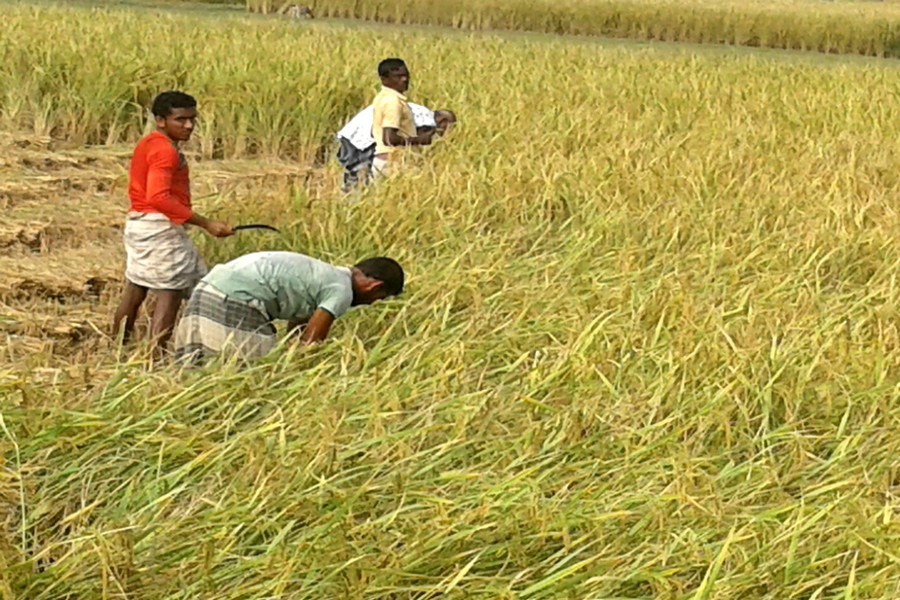
Published :
Updated :

That the country's farm sector has added another feather to its cap by producing record amount of paddy is highly satisfying. It is more so because of the drop in yield for two consecutive years after then record yield in 2015. The previous year's unexpected damage of standing crop in haor (wetland) area suddenly changed agricultural map of the country. It was scary indeed; because the country was caught off guard after its claim that on achieving near self-sufficiency in rice, time was for it to go for export of the staple. Actually, the country started exporting fine rice in particular and some medium variety on a limited scale.
The economy of rice soon witnessed hectic political and commercial manoeuvring. Its overall upshot was price rice to a new high. Although, global paddy production was satisfactory last year and the price in the international market did not register any hike at all, the millers and traders here made the most of the situation to trigger price escalation. Even the quick move by the government to bring down import duty from 28 per cent to 2.0 per cent was not enough to combat the artificially engineered price hike of the staple.
Notably, farmers were complaining for a few years before the previous year's reversal in paddy cultivation that the market price of their produce at the grower's level initially left no profit margin and in some cases caused them losses. A maund (a liitle over 37 kilograms) of paddy was sold on an average at Tk 500 whereas the production cost would vary from Tk 500-600. Last year, the prices of paddy stayed between Tk 800-900 a maund. By this time chemical fertiliser and other inputs became costlier and although there was a margin of profit for farmers, it was not as wide as the gap between Tk 500 and Tk 800 or Tk 600 and Tk 900.
Looked from another angle, the reversal in yield last time proved somewhat like a blessing in disguise. Continuous fall in paddy price at the field level previously prompted farmers to seriously look for options for cultivation of alternative produces. Actually, a few switched over to growing vegetables and even some exotic fruits.
Now much of the rice economy will depend on how the record yield of this year is manipulated or not by the business circle. Here the official version of the issue is quite interesting. It holds that at no point rice price should be brought down to a level where farmers will incur losses on cultivation of paddy. No argument here. But how much will the gap between prices at the farm gate and at the consumer level be rational? If a kilogram of coarse rice is sold at Tk 26-28 in a village market, it should not be priced at Tk 40-45 in the capital or other cities. But this has been the trend of price line in this country for years now. Should transport cost and profit for the middlemen push up the price of a kilogram of rice to Tk 12-15 in excess?
Now that the government has acted very promptly by slapping once again 28 per cent duty on import of rice apparently in order to protect farmers' interests, its effect has become quite visible. In the past two months, the country's total import fell drastically to 38,060 tonnes only. The US Department of Agriculture has predicted that Bangladesh's import of rice would drop to a mere 0.6 million tonnes in 2018-19. This is in sharp contrast to the 3.90 million tonnes -highest in the past three decades -- the country's private and public sectors imported last year. The government's prompt action is likely to resist an abnormal slump in rice price and will definitely discourage import.
So long as the prices of rice at the consumer level stay where they are now, millers and rice traders have nothing to lose. But the problem will arise when a glut of the produce will push down the prices at the growers' level. Farmers will be forced to dispose of their produce at prices lower than what should be the reasonable rate. Millers and other middlemen are adept in taking opportunity of a sluggish market. The government is not known to have successfully intervened when abnormal price fall stare in the face of the growers. Its procurement drive is naively conducted and its benefit rarely reaches those for whom it is intended.
Even in the prevailing situation, consumers at the low and and high end deserve some benefit from the record yield of the staple. Millers and traders have advanced excuses one after another to deprive both growers and consumers of the reasonable benefits. Here the country's transportation system is largely to blame. No way transportation can be economical if the main vehicle for the purpose is truck. Imagine, if goods trains could be used for carrying rice and other agricultural produces, perishable items in particular, how the carrying cost could be brought down to a negligible rate. This would, moreover, have done with the illegal toll collection at several points on the road.
Rice economy and for that matter the economy of any farm produce could be bolstered by expansion of railway service. It could also be of great help to provide momentum to people's movement -a precondition for enhancing domestic trade and commerce. Until this happens, an alternative arrangement can be distribution of trucks among farmers by forming their cooperatives. The cooperatives will fully own the vehicles once the loans are paid up. This is how the manipulative exploitation of farmers can be staved off.


 For all latest news, follow The Financial Express Google News channel.
For all latest news, follow The Financial Express Google News channel.